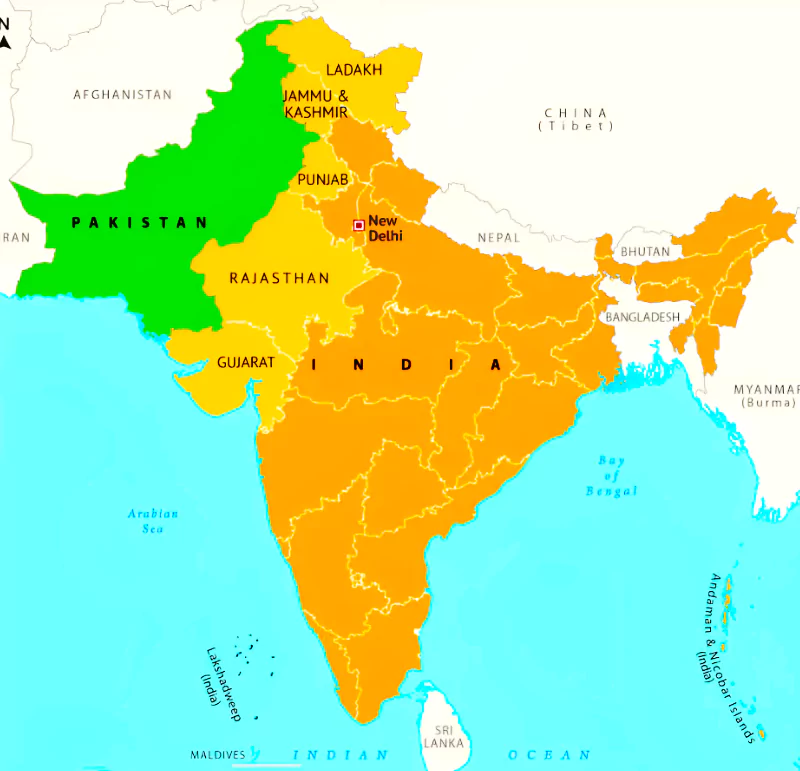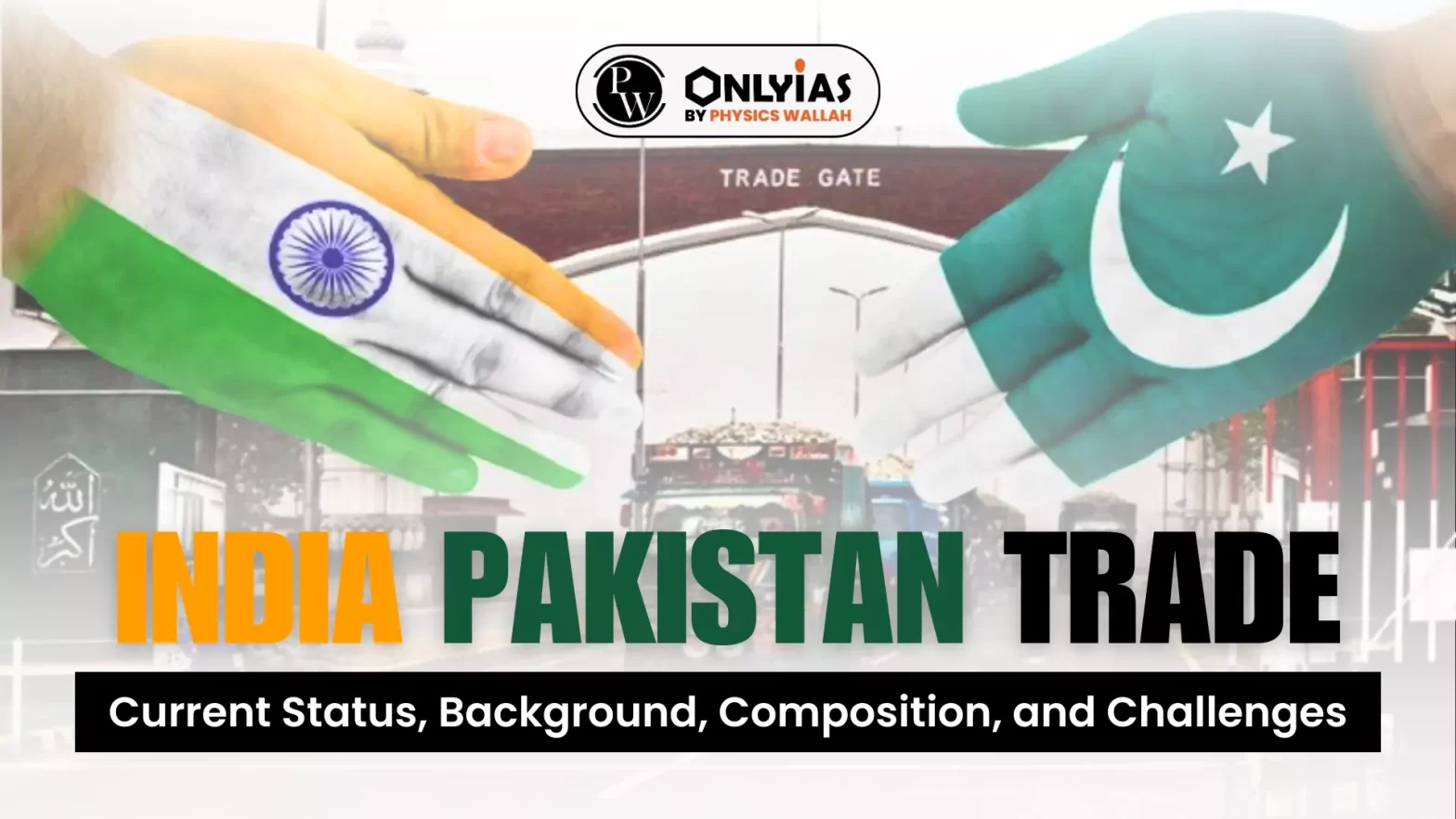Context
According to Pakistan’s Foreign Affairs Minister, Pakistan is going to seriously examine the question of resuming trade with India.
Background of India Pakistan Trade
- Suspension of Bilateral Trade: Pakistan suspended bilateral trade with India in August 2019, after the Indian government abrogated Article 370 of the Indian Constitution.
-
- Article 370 gave a special status to the erstwhile state of Jammu and Kashmir, following its accession with India in 1947.
- Withdrawal of MFN Status: India withdrew Pakistan’s MFN status in the aftermath of the Pulwama terrorist attack in 2019 which led to the deaths of 40 personnel.
- An underlying reason for suspending trade was the 200% tariff imposed by New Delhi on Pakistani imports earlier that year after India revoked Pakistan’s Most Favoured Nation (MFN) status.
About Most Favoured Nation Status
- MFN Principle: It aims to promote non-discrimination and equal treatment in international trade, which can lead to increased competition, lower prices for consumers, and greater economic growth.
- Agreement: It is a part of the World Trade Organisation’s General Agreement on Tariffs and Trade (GATT), 1994.
- Objective: All member countries of the WTO should accord MFN status to all other member countries.
- Significance: This would ensure free and open trade and that all members treat each other equally as trade partners.
- Exceptions to the MFN Principle:
- Countries can form free trade agreements (FTAs) like NAFTA or the European Union, where they lower tariffs only for the countries within the FTA.
- Countries can give special treatment to developing nations to help their economies grow.
- In cases of dumping or unfair subsidies, countries can impose higher tariffs on specific goods from a particular country.
|
Composition of India Pakistan Trade
-
Bilateral Trade:
- In FY17, India Pakistan trade was a mere $2.29 billion, or about 0.35% of India’s overall trade.
 In 2018-19, cotton ($550.33 million) and organic chemicals ($457.75 million) accounted for around half of Pakistan’s imports from India.
In 2018-19, cotton ($550.33 million) and organic chemicals ($457.75 million) accounted for around half of Pakistan’s imports from India.
-
Other Major Pakistani Imports from India:
- In 2018-19, included plastic ($131.19 million), tanning/dyeing extracts ($114.48 million), and machinery, and mechanical appliances ($94.88 million).
-
India’s Imports from Pakistan:
-
- In 2018-19, included mineral fuels and oils ($131.29 million), edible fruits and nuts ($103.27 million), salt, sulphur, stone and plastering materials ($92.84 million), ores, slag and ash ($17.18 million) and raw hides and leather ($16.27 million).
-
Pakistan’s Negative List:
- Despite having MFN status since 1996, Pakistan maintained a Negative List of 1,209 products that were not allowed to be imported from India.
- Only 138 products were allowed to be imported from India through the Wagah-Attari border land route.
-
India’s Trade Surplus:
- India maintained a significant trade surplus over Pakistan, meaning the total value of goods and services it exported to Pakistan was much larger than the value of goods and services it imported from Pakistan.
Challenges Associated with India Pakistan Trade
- Indirect Trade: Pakistan’s imports from India arrive via Dubai or Singapore, resulting in extra freight, extra transhipment, transportation costs, etc.
- Trade- Ban: Pakistan’s imports fell drastically between April 2020 and January 2021, while cotton imports stopped altogether.
- The only increase was in pharmaceutical products, as Pakistan looked to ensure sufficient supplies of medicines during the Covid-19 pandemic.
- Policy Instability: In 2021, Pakistan’s Economic Coordination Council, a top decision-making body, allowed the import of cotton and yarn from India.
- A low domestic yield and the high cost of imports from the likes of Brazil and the United States were believed to be the reasons behind the change of stance.
- However, then Prime Minister Imran Khan again discontinued trade.
Why Might Pakistan be Reconsidering Trade with India?
- Political Change: There has been a change in Prime Minister following elections held earlier this year.
- While the Pakistani military remains firmly in control, a new government indicates the possibility of a new policy.
- Turbulent Economy: Pakistan’s economy has been in dire condition following the devastating floods in 2022, high inflation, and political instability alongside structural issues, have led to multiple crises related to meeting the food and energy needs of the population.
- Dependence of External Support: Pakistan has had to frequently approach the International Monetary Fund (IMF) or friendly countries like Saudi Arabia and China for billions of dollars in loans.
- With the pause in trade with India, importing goods from faraway countries further depletes its low foreign exchange reserves.
Why is Trade with Pakistan Beneficial for india?
As a result of partition, traders from Punjab suffered significant repercussions. Thus, establishing a trade mechanism with Pakistan could facilitate Indian exports to Iran, Afghanistan, and Central Asia.
Conclusion
Amid political shifts and economic challenges, Pakistan’s reconsideration of trade with India signals potential for diplomatic and economic recalibration.
Also Read: Free Trade Agreements (FTAs) And Beyond

 In 2018-19, cotton ($550.33 million) and organic chemicals ($457.75 million) accounted for around half of Pakistan’s imports from India.
In 2018-19, cotton ($550.33 million) and organic chemicals ($457.75 million) accounted for around half of Pakistan’s imports from India.